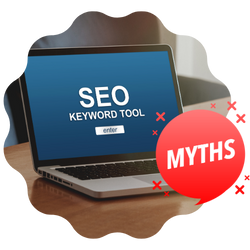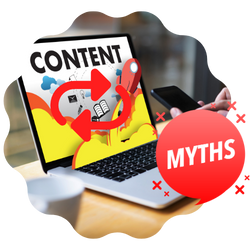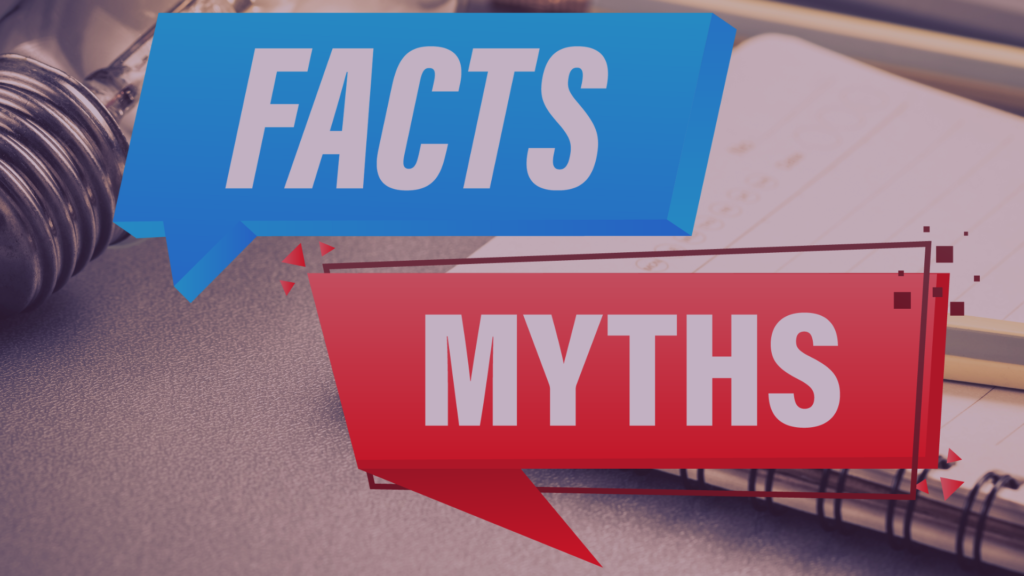10 Content Writing Facts and Myths
With content writing being a vital and vibrant aspect of contemporary communication, and as the digital landscape changes, the facts and myths about being a content writer changes, too. These misconceptions encourage aspiring content writers who believe that it’s as easy as pie or discourage them because it’s the devil of a job!
But, as veteran content writers will tell anybody who asks, content writing has its challenges and rewards, and misconceptions about it aren’t based on facts. Here are 10 that we believe you should know before taking the plunge.
Myth 1: Content Writing Is Easy and Anyone Can Do It

Of all the facts and myths about being a content writer, the myth that content writing doesn’t require specialized skills is among the absurd ones! This misconception is the result of the popular notion that writing being a basic skill, particularly among college-educated individuals, content writing shouldn’t be too hard. Just string words together, look out for grammar and spelling errors, and voila – content with value!
But individuals who believe in such a misconception underestimate the complexities of professional content writing. Let’s take a look at a few of these complexities.
Writing Skill and Craftsmanship
Nearly every Tom, Dick and Harry can string words together but professional content writers are skilled at creating valuable, impactful and engaging content! Doing so demands proficient understanding of the language and its style, structure and grammar as well as its nuances that make for concise, clear and informative content.
The result: Content that resonates with its target audience, encourages readers to engage in a meaningful manner, and enables them to perform the desired actions (e.g., buy, share or recommend). Indeed, engagement and conversion are at the heart of effective content writing, and it demands writing skills and craftsmanship developed over time.
Extensive Research
Content writing isn’t pulling ideas out of the top of your head, far from it! Professional content writers perform extensive research about every topic to ensure accuracy and credibility. This is true even for topics familiar to them, mainly because of the fast obsolescence of information in the digital age. Being updated about the latest is a must, whether it’s about Hollywood gossip or artificial intelligence.
By gathering relevant information from reliable sources, professional content writers can understand complex topics and write content in a way that their target audience can understand and act on.
Audience-centric Approach
Effective content writing requires an audience-specific approach! Professional content writers must have reliable information about their target audience – what their preferences, pain points and needs are, among others. Their content must be in accordance with these audience-specific factors – and it’s a job that demands careful consideration, planning and editing.
SEO Considerations
But audience-specific content will be of little to no use if it doesn’t reach the target audience! This is where search engine optimization (SEO) comes in, and professional content writers must know its basics (e.g., keyword research and usage) for first-page search engine results rankings.
Professional content writers must also adapt content to different platforms and formats, accept constructive criticism and feedback during the editing process, and adopt an attitude of continuous learning. Their job also demands not just the ability to meet deadlines but also to maintain the quality and relevance of their content over time.
Myth 2: Long Blocks of Text Are Okay

Among the content writing misconceptions borne of the misunderstanding about the way online content consumption works is that long paragraphs with little to no formatting is acceptable. By providing extensive information in a single article, the content becomes more valuable. The reasoning behind the myth: Long blocks of text mean that online readers will see the content as being comprehensive and authoritative.
But there are several issues with long blocks of text!
Scannability of Content
Digital content must be scannable because readers want an easy and quick assessment of the information contained therein, particularly its relevance to their needs, before reading it in full. Professional content writers ensure scannability of content by using short paragraphs, subheadings and bullet points, among others. These formatting elements make it easier and faster for online readers to navigate content and find the information they want.
Short Attention Span
With the availability of information in the digital landscape, among other reasons, the typical online readers have shorter attention spans. According to a Microsoft study, online users have an eight-second attention span, meaning content writers must hook readers within eight seconds! In those eight seconds, skimming through content while looking for headings, visual aids and key points is common – and it’s supported by eye-tracking studies, too.
Mobile Access
Mobile web traffic accounts for nearly 50% of total web traffic. With mobile devices having smaller screens, the importance of scannable content cannot be overemphasized! Breaking up long blocks of text into shorter paragraphs and using headings, bullet points and visual aids make it easier for mobile users to read content.
Audience Engagement
Long blocks of text without formatting contributes to high bounce rates, meaning online visitors leave web pages shortly after arrival. Being overwhelmed by the wall of text is a significant factor here.
With a high bounce rate comes a missed opportunity for meaningful audience engagement, too, no thanks to your target readers getting out of your page. But when your target readers are hooked within seconds, then there’s a higher chance for engagement.
Now think of readers with reading disabilities, visual impairment or attention deficit and you have more reasons to use formatting elements in your content.
SEO Considerations
Comprehensive content has its merits, particularly when you’re establishing your reputation as an authority in the field. But it’s bad news for SEO purposes. Search engines consider user experience in their search engine results pages, too. The rule of thumb here is that pages with higher bounce rates and shorter dwell times are less likely to land on the first page.
Again, effective formatting resulting in better scannability and readability can have a positive impact on SEO.
Myth 3: Keyword Stuffing Is Excellent for SEO Purposes

Yet another of the SEO-related content writing misconceptions is that overloading content with keywords will result in first-page search engine rankings. Known as keyword stuffing, it’s now an outdated concept due to its ineffectiveness in search engine results pages (SERPs). In fact, it’s widely considered as a counterintuitive and counterproductive technique that can even result in content being considered spam.
Here are the facts about the use of keywords for SEO purposes.
Keyword Relevance
Keywords are crucial for effective SEO but their quality – think context and relevance – in the content are more important than their quantity! Search engines want positive user experiences for Netizens and it’s achieved by using keywords in an organic manner within engaging, informative and actionable content.
User Experience
Keyword stuffing makes content sound repetitive, if not unnatural, resulting in difficulty reading it. The result is negative user experience that contributes to high bounce rate and short dwell time, meaning lower SERPs.
Algorithm Updates
Search engines, particularly Google, perform regular algorithm updates that determine websites engaging in keyword stuffing and penalizing them. The penalty: A significant drop in their rankings. The Panda and Hummingbird algorithm updates are noteworthy for their emphasis on keyword stuffing among websites.
Keyword stuffing can even result in the complete removal of erring websites from search engine indexes! Since erring websites won’t appear in SERPs at all, their online visibility and organic traffic are severely affected.
Latent Semantic Indexing
There’s also the matter of latent semantic indexing (LSI), a technique used by search engines in understanding the context of content. Search engines recognize keywords including synonyms in relation to the content’s overall topic, meaning keyword stuffing is unnecessary for SEO purposes.
The bottom line: Effective content writing is about quality, value and variety – not keyword stuffing – and these elements contribute to positive user experiences.
Myth 4: Content Can Be Repurposed Without Changes

Many content creators and marketers use existing content and post them on different platforms, usually with different audiences, without making significant changes in their core message and related information. Of course, repurposing existing content has its merits, but it should be adapted based on the specific platform and audience! Otherwise, there will likely be duplicate content issues and negative user experiences, among other adverse consequences.
Here are the facts about and benefits of proper repurposing of content, among the primary responsibilities of a content writer.
Cost-efficient Method
Repurposing content is a cost-efficient strategy since more value can be extracted from the original content, usually by leveraging existing content and creating new pieces from ideas briefly introduced in it.
Repurposing content also means significant time savings since there’s no need to start from scratch to create new content. The time saved can then be used for other important tasks with more urgent deadlines.
Expanded Audience Reach
Online audiences have different preferences in format when consuming content. When repurposing content, it’s important to give the same or similar message and information in different formats, such as infographics, videos and podcasts. Doing so means getting your core message out into different audiences across multiple platforms.
With repurposed content, professional content writers can also engage their target audience in new ways. Audience engagement being the bread and butter of content writing, the opportunity just cannot be missed!
SEO Benefits
Repurposing content in a meaningful manner means targeting different keywords and keyphrases while still remaining true to your core message. In doing so, it’s possible to improve your website’s SERPs rankings and to capture a wider audience through broader search queries.
Brand Consistency
By maintaining your core message while repurposing content, you’re able to maintain brand consistency across multiple platforms and channels. This will contribute to increased brand recognition and recall and enhanced brand identity.
Repurposing content also targets different stages of the sales funnel while maintaining brand consistency. For example, an informative blog post about products and services for new visitors can be repurposed into a comparison chart for potential buyers in their decision-making phase.
Evergreen Content
Repurposing content also means evergreen content, meaning content that remains valuable, relevant and reliable over time. The trick is in regular updates on the content, such as new statistics and examples, which support the core message. The main content structure remains as is or can be changed in accordance with the target audience’s preferences.
Professional content writers also repurpose content for experimentation purposes. By offering audiences different formats and styles, it’s easier to identify the best ones that resonate with them. The storytelling flexibility that comes with repurposing content means that content writers are also able to maximize limited resources.
Myth 5: Technical Writing Should Be Complex and Formal

There are several misconceptions related to technical content writing, of which the most common being that it should be formal in tone and consist of complex words. Apparently, using sophisticated language is a demonstration of writing prowess!
But this isn’t true in content writing at all. Technical content should be clear and concise, as well as contribute to positive user experiences that will increase readership. The tone of technical content should also match the audience and context, meaning a conversational tone can be adopted even for science-y topics.
Here are more reasons why technical writing shouldn’t be formal in tone and complex in structure.
Audience Understanding
Keep in mind that the goal of content writing is to communicate core messages and their relevant information effectively. The use of complex language and formal writing styles can make it difficult for the general audience to understand them.
With decreased understanding, there’s less audience engagement. But with a more conversational and relatable style, there’s more possibility for audience engagement and connection.
Content Accessibility
While technical content has its specific audience, such as the science community, there are instances when it’s also intended to reach a wider audience. The use of a more conversational tone and less complicated language makes it easier for technical content to be distributed across different platforms and channels.
The online reading habits of Netizens also means clear and concise writing for technical content makes it more effective in grasping its main points. Skimming and scanning content being the norm, getting relevant information a few seconds into the technical content means more engagement and accessibility, too.
Professional content writers also use conversational styles in technical content since it contributes to greater variety, acknowledges the cultural diversity of online readers, and fits in well on social media.
Myth 6: Writing Speed is More Important Than Quality

The primary role of content writer in digital marketing is to produce compelling content that meets SEO goals, drives organic traffic to the website, and builds brand authority, among other goals in support of digital marketing campaigns. This is where the misconception about writing speed and quantity being more important than quality stems from. Basically, creating a large quantity of content will automatically result in higher SERP ranking and audience engagement.
But it’s a myth! The best content writers balance quantity and quality, usually without rushing their content writing activities. Note that, more often than not, content that has been written in a rushed manner lacks accuracy, compelling points, and depth.
Here are more facts about the quantity versus quality debate.
Effect on Overall Reputation
When a website publishes a high quantity of low-quality content, its overall reputation in its market segment will suffer sooner than later. Both search engines, particularly Google, and online audiences value high-quality content that delivers on relevance, reliability and value.
The bounce rate is lower and the dwell times are higher in websites with valuable content, meaning more audience engagement. In turn, online audiences are more likely to spread the word about these websites and, thus, multiply the effect.
Impact on Productivity
Of course, cost efficiency is crucial in digital marketing but equating speed with productivity in content writing will likely result in low-quality content. Content writers must take their time in planning, writing and editing every piece of content to ensure relevance, reliability and value. This is true whether creating new content or repurposing existing content for different platforms and channels.
Myth 7: Content Writing Yields Immediate Results

As previously mentioned, the primary role of content writer in digital marketing is to meet SEO goals, such as keyword integration, meta tags, and internal linking, in relation to creating high-quality content. The general consensus, however, seems to be that high-quality content will yield immediate and significant results, such as increased SERP ranking, engagement and/or conversions.
But this is far from the truth! Content marketing as part of an effective digital marketing program is a long-term strategy. Even with consistent publications of high-quality content, it will take time for a website to gain online visibility among its target audience, rank on SERPs, and build a loyal following. Indeed, patience is a must for professional content writers.
Here are more facts about content writing and its expected results.
SEO Takes Time
Professional content writers know that their job’s main responsibility is increasing a website’s visibility on search engines. But it takes time because SEO is a long-term strategy involving numerous different but interrelated activities. These include optimizing content, building backlinks, and establishing domain authority.
Search engines take time to index and rank new content on the Internet. Think about it: Approximately 328.77 million terabytes of data are created every day! In the US alone, there are more than 2,700 data centers. With so much new data created, noticeable improvements in SERPs usually require several months of quality content and consistent effort.
There’s also the matter of algorithm changes that impact content distribution platforms. Professional content writers must adapt to these changes if and when they want their content to gain visibility and build traction.
Content Promotion Is Crucial
Merely creating and posting content isn’t enough – it’s equally important to promote it and that takes time, too. Effective content promotion strategies that take time to see results include sharing content on various platforms, collaborating with influencers in reaching target audiences, and leveraging email marketing campaigns.
Building trust among your target audience and establishing your authority in your niche also requires time, consistent effort, and quality content over time. Content promotion is part of a holistic strategy in this regard.
Content Consumption Over Time
The time for the consumption of content also has a significant impact on the effectiveness of content. Online users consume content at different times, in different stages of their lives, and on different platforms, and they can come across the same content over several weeks, months and even years after its first publication. The delayed engagement contributes to the content’s prolonged impact – and it changes over time, too.
Conversion Funnel Complexity
The way that online audiences see a specific piece of content changes as they move through the conversion funnel, too. Their progression starts from awareness of the content to action on it, whether it’s to buy a product or subscribe to a service. Since the decision-making process from awareness to action can take time, content must be adapted (i.e., repurposing) during the process.
Myth 8: Content Is Only for Search Engines

This content writing myth suggests that the primary purpose of creating online content is boosting search engine rankings and increasing organic traffic. The myth also implies that creating content satisfies algorithms first while the relevance, reliability and quality of the content for human readers is a secondary concern.
User Experience Comes First
Always! While SEO is a crucial aspect of content writing, content is primarily created for human readers. Indeed, search engines increasingly focus on providing Internet users with positive user experiences through valuable, relevant and reliable content. Said content, which educates, entertains, and even provides solutions and answers, are more likely to attract organic traffic.
Also, user experience metrics influence search engine rankings. This is particularly true for bounce rate and dwell times on web pages and their content.
Backlinks and Social Sharing
Search engines consider social shares and backlinks made by other websites to a particular website in its ranking algorithms. These social shares and backlinks also increase overall online visibility and referral traffic. In turn, it enhances a website’s brand identity, recall and recognition among its target audience resulting in long-term success beyond SEO and SERPs.
Effective content writing also emphasizes the use of natural language patterns, not keyword stuffing, because it contributes to enhanced readability and user experience. Content must also be adaptable to various formats, correspond to user intent, and align with business interests, all of which are related to humans and their user experiences, not for search engine-pandering purposes.
Myth 9: Editing Isn’t Necessary With Spell Check Apps

The myth that human-driven editing is unnecessary and unimportant if spell check and other related apps are used stems from the notion that these tools address the complexities of content writing. But just as content should be created for human readers, content writing should be done by humans, from start to end!
Here are reasons why humans must still edit content even with spell check apps and other digital tools.
Grammar and Syntax
Basic spelling errors and grammar mistakes are the domain of spell checkers. But among the responsibilities of a content writer is ensuring the proper structure, formatting and syntax of content, as well as ensuring its clarity, coherence and consistent style, voice and tone. Even artificial intelligence apps fall short in these aspects!
Furthermore, spell check tools fall short of ensuring that words are used in the proper context within the content. What use, after all, are properly spelled words that are out of place and serve little to no purpose?
Fact-Checking and Accuracy
Professional content writers must check the accuracy of the information presented in their work, an editing task that involves verifying the sources, statistics and references. Spell check tools aren’t equipped for this task! We cannot overemphasize the importance of fact-checking and accuracy in ensuring engaging, informative and compelling content.
Of course, spell check tools have their uses in the content writing process but these aren’t substitutes for content writers and editors.
Myth 10: Nothing’s Original Because All Topics Have Been Covered

With millions of content being generated daily, there’s little to no room for original, novel and new content because everything that can be said has already been said, restated and rephrased! This can be a discouraging thought for content creators and contribute to their feelings of frustration. After all, what more can you do when your ideas are insignificant, unoriginal, or redundant?
Fortunately, this is just a myth and there are many facts of content writing that disproves it, too!
Unique Perspectives
Every topic that comes to mind may have been extensively covered before but each content creator brings their own experiences, insights and perspective into the matter! This can result in new interpretations and angles, even fresh takes, on subjects that may be considered well-worn.
Changing Context
With the world in constant flux, there’s always something new in old topics! New discoveries and advancements can make what was true a few years ago false now. Content creators can then change their strategies, core messages and information based on what’s new.
Other reasons why something old can be turned into something new, content-wise, are the interdisciplinary connections that result in novel content, unexplored subtopics or niche areas, and creative synthesis resulting in novel creations.
But overcoming the mindset that nothing’s original anymore demands embracing creativity, inspiration and imagination! You must let your unique personality and perspective shine through in every content.

